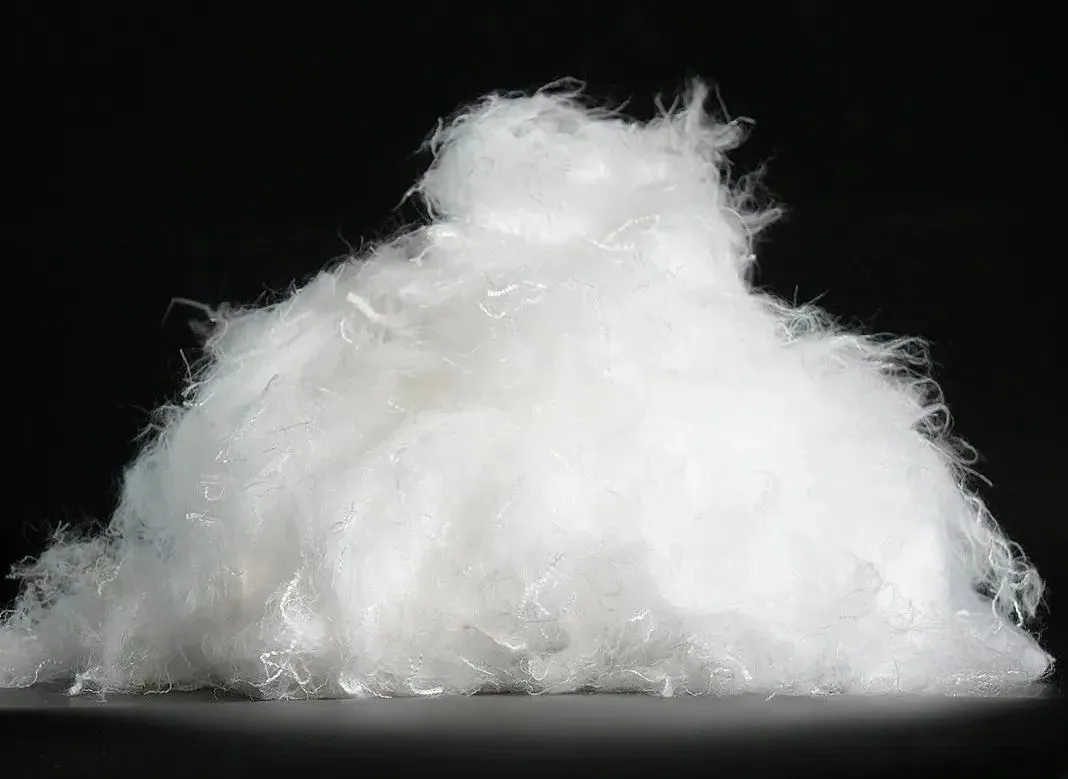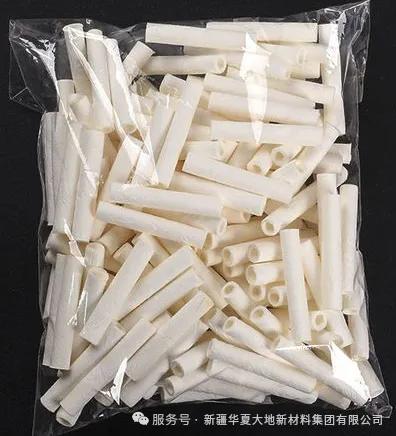Poly(lactic acid) filament for cigarette filters
Polylactic acid (PLA) is a biobased material and is one of the most promising fiber materials in the 21st century. It does not exist in nature and needs to be artificially synthesized. The raw material, lactic acid, is produced by fermenting crops such as wheat, sugar beets, cassava, and corn, or non-crop materials like waste straw. Products made from PLA can be degraded into water and carbon dioxide under composting conditions. PLA is widely used and can be processed into plastics or fibers, making it a material that combines both fibers and plastics.
Project Introduction
The traditional cigarette filter tips have problems such as poor degradability and insufficient adsorption of harmful components. However, the poly(lactic acid) filament-forming filter rod, with its innovative structure and materials, has initiated a revolution in the industry!
Structural innovation, enhanced fragrance efficiency
The middle poly(lactic acid) sheet, combined with the cross-woven poly(lactic acid) filaments on both sides, forms adsorption holes with a standardized distribution. This unique design enables it to have an extremely strong adsorption capacity for fragrance solutions. When used with low-temperature non-burning new tobacco, the fragrance enhancement effect is truly outstanding, providing consumers with a brand-new taste experience.
Green and environmentally friendly, saying goodbye to pollution
The fragrance sheet and filter rod formed by poly(lactic acid) completely solve the problem of traditional non-woven fabric's inability to degrade. After use, they can naturally degrade, reducing environmental pollution, and practicing green production concepts, promoting the sustainable development of the tobacco industry.
Outstanding performance, unlimited potential
The poly(lactic acid) filter rod has low cost, and its polar molecular structure has extremely strong adsorption and removal capabilities for harmful components in cigarette smoke. Once launched on the market, it will undoubtedly break the industry pattern with its high cost-effectiveness and excellent performance, seize a broad market space, and become the new benchmark in the tobacco filter field!
The Application of Polylactic Acid in Cigarette Filters: Feasibility and Prospects
In the context of the continuous pursuit of innovation and sustainability in the tobacco industry, polylactic acid (PLA), as a new type of material, has gradually emerged in the application field of cigarette filters. PLA is a biogenic and degradable aliphatic polyester material, possessing numerous advantages that make it a strong alternative to traditional filter materials.
From an environmental protection perspective, polylactic acid is derived from renewable plant resources such as corn and wheat, reducing the reliance on petroleum resources. The discarded polylactic acid filters can gradually decompose in the natural environment under the action of microorganisms, effectively avoiding the environmental pollution problems caused by the difficulty in degradation of traditional filter material. This meets the global demand for environmentally friendly products.
In terms of technical characteristics, the polymer chains of polylactic acid contain highly polar acetyl groups, which have a strong affinity for polar substances. During the process of cigarette combustion, it can undergo chemical reactions and adsorption with tar components and low-molecular substances, thereby effectively reducing the harmful substances inhaled by the human body. At the same time, the surface of the polylactic acid filament has micropores and a rough texture. During the adsorption of smoke gas, not only is there a physical adsorption effect, but there is also a chemical adsorption effect. This dual adsorption effect significantly improves the filtration efficiency.
In terms of performance, polylactic acid fibers have a similar structure to acrylonitrile fibers. The surface of the filament of polylactic acid fibers is rich in micropores, and the molecular surface has numerous functional groups, resulting in good adsorption effects. Moreover, polylactic acid fibers are harmless to the human body, have better health properties than acrylic fibers, have low smoke generation, are not flammable, have good antibacterial properties, and have higher safety.

After being spun and formed, polylactic acid (PLA) can be transformed into polylactic acid fibers. These polylactic acid fibers combine the advantages of natural fibers and chemically synthesized fibers, having a weak acidity similar to that of human skin. They are naturally skin-friendly, antibacterial, antihistamine, and anti-allergic. They have excellent drapability, smoothness, breathability, and a lustrous appearance. Moreover, the textile products made from polylactic acid fibers also have the characteristic of self-extinguishing, ensuring high safety in use.
The advantages of poly(lactic acid) fiber cigarette silk bundles
Because the smoke released during cigarette combustion contains substances such as tar and nicotine (nicotine) which are harmful to human health, it is required that the cigarette filter can remove the harmful components in the smoke. In addition, the filter must have appropriate resistance to inhalation, hardness, rod weight, roundness and comply with hygiene standards.
In the traditional cigarette industry, the main material for filter tips was cellulose acetate. For cigarette use, the main type was diacetic acid, also known as diethylene glycol cellulose. Polypropylene fiber is also called polypropylene cellulose. Apart from the low-end cigarettes, it is still used in some other products. The rest are counterfeit cigarettes and privately-made cigarettes. The cigarette filter tips made of diacetic acid cellulose filament have the advantages of being non-toxic, odorless, low oxygen absorption, good adsorption effect, firm texture, high efficiency in retaining smoke tar, good elasticity and thermal stability. Therefore, diacetic acid cellulose filament is widely used in the tobacco industry.
Overall, the poly(lactic acid) fiber cigarette filter tip has the following advantages.
Good biodegradability: Polylactic acid (PLA) is derived from natural plants and can be naturally decomposed by the human body. It can completely degrade into carbon dioxide and water in the environment within a few months, posing no potential harm to the environment. Compared to traditional cellulose acetate filament filter materials used in tobacco, it is more environmentally friendly.
Strong adsorption performance: The poly(lactic acid) (PLA) fiber strand has a strong adsorption capacity and elimination ability for harmful components in the smoke. It can effectively adsorb aldehyde-ketone compounds, heavy metal ions and other harmful substances in the mainstream smoke of cigarettes, thereby reducing the harm to the human body.
Similar smoke and taste to acetate fiber filter: The filter made of polylactic acid (PLA) fibers has a smoke and taste on cigarettes that is similar to that of acetate fiber filter. It can meet the needs of consumers and is a feasible alternative to filter material.
The potential as an alternative for cigarette filter tubes made of polylactic acid fibers
At present, the total global output of cellulose acetate fibers is approximately 750,000 to 800,000 tons, accounting for 3% of the world's total chemical fiber production. Among them, the silk fibers for cigarettes amount to about 550,000 to 570,000 tons, which constitutes the main proportion. The price of cellulose acetate fibers is approximately 20,000 yuan per ton, and it is a very high-grade material. The prices of nicotine and cantharidin extracted from cigarette butts are even higher. The value of cigarette-specific cellulose acetate fibers in China reaches 4 billion yuan.
The data from 2013 shows that the market demand for tobacco-grade acetic acid fiber filaments in China was approximately 280,000 tons.
The preparation method of poly(lactic acid) fiber cigarette silk bundles
Modified activated carbon and polylactic acid composite spinning method: First, the activated carbon is treated with ammonia water to obtain pre-modified activated carbon. Then, the pre-modified activated carbon is alternately immersed in an anionic polyelectrolyte solution and a cationic polyelectrolyte solution using the layer-by-layer electrostatic self-assembly technology to obtain modified activated carbon. At the same time, modified polylactic acid is prepared by reacting polylactic acid with allyl quaternary ammonium salt. Next, the modified polylactic acid and modified activated carbon are mixed to form a skin layer spinning solution, and then hollow porous polylactic acid fibers are fabricated through coaxial electrospinning. Finally, the fibers are processed through drawing, curling, drying, etc. to obtain degradable polylactic acid fiber bundles.
Adding filler reinforcement method: Add carbon nanotubes, modified zeolite powder and other fillers to polylactic acid to enhance the mechanical properties and heat resistance temperature of the polylactic acid composite material. For example, first modify the carbon nanotubes, then mix and melt them with modified zeolite powder and polylactic acid, and spin to obtain the initial fiber bundle of polylactic acid. Then, stretch, curl and heat set the initial fiber bundle to obtain the polylactic acid fiber bundle used for cigarette filter tips.
Blending modification method: Mix poly-L-lactic acid, poly-D-lactic acid, poly-lactic acid copolymer, stearic acid and its salt compounds in a certain proportion evenly, then extrude and granulate to obtain modified poly-lactic acid resin particles. Next, add the particles to the spinning machine for spinning. After cooling, stretching and shaping treatment, a biodegradable cigarette filter filament bundle can be produced.
Polylactic acid fibers have been successfully applied in various industries and fields such as textiles, industry and agriculture, and have great market potential waiting to be developed. Especially, the biogenic source and biodegradable characteristics of polylactic acid itself make it play a significant role in replacing the existing non-degradable fabrics and non-woven fabrics as an environmentally friendly material, promoting green environmental protection. It is one of the key development products in textiles and non-woven fabrics in the 21st century.

The filter tip rod is formed by a poly(lactic acid) filament bundle. It consists of a central poly(lactic acid) sheet and poly(lactic acid) filaments woven crosswise and interlaced on both sides of the central sheet. The filaments form a distribution of adsorption holes, which have good adsorption properties for fragrance solution. The added fragrance effect is excellent when applied after the filter tip, especially for the new type of tobacco that does not burn at low temperatures. Meanwhile, the fragrance sheet formed by poly(lactic acid) can solve the problem of non-degradable non-woven fabric in the current process.
The poly(lactic acid) filament filter tips produced in China are low in cost and easy to degrade. What's more, their polar molecular structure enables them to have extremely high adsorption and removal capabilities for harmful components in the smoke. Once they are launched onto the market, they will bring a significant transformation to the entire cigarette filter tip industry. Therefore, the market potential is extremely broad.


